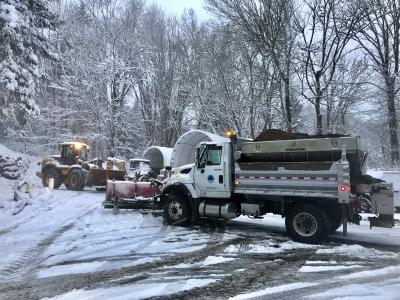Snow and Ice Response Plan
The Public Works Department's goal is to provide sanding, plowing and de-icing services on public streets that allow traffic to enter and leave the Island safely when winter weather brings snow and ice. The City has six plows, three of which have sander units; one truck is used mostly for liquid de-icing.
The City focuses first on priority routes that access I-90, schools, and the Town Center. This includes arterials such as:
- Island Crest Way
- Gallagher Hill Road
- East Mercer Way
- West Mercer Way
- North Mercer Way
- Mercerwood Drive
- SE 40th Street
- SE 68th Street
- 70th Ave SE
- 72nd Ave SE
In addition to plowing and sanding, crews also apply liquid deicer to pre-treat other arterials located on steep hills and major intersections prior to cold weather events.
When arterials are safe to travel, crews begin working next on residential streets. Crews also respond to snow and ice situations at the request of Mercer Island Police. Unfortunately, the City does not have the personnel or equipment to clear residential neighborhoods until the main arterials are clear and passable, and must prioritize time and resources. Note: During snowstorm events, crews will be focused solely on snow removal for priority routes.
- Map: Privately Maintained Roadways
- Map: Deicing Pre-Treatment Locations
- Map: Snow Removal Priority Streets
- Map: Streets Likely to be Closed
To report a snow problem, or request sanding/deicing after a storm, please use the City's online service request portal MI-Connect (or download the app). This pushes requests directly into the workflow queue for City field crews.
For an updated list of road status, known incidents, etc, visit the City's Let's Talk site here.
For missed Recycling, Compost, and Garbage collections, contact the City's contracted hauler, Recology. When service is canceled, residents can usually put out doubles on the following week at no extra charge, or take materials to a central, overflow location.
Winter Driving Tips
Know the road conditions and check the WSDOT website for updates. Know your vehicle, use proper driving techniques for the conditions, and have the right emergency gear and equipment along with you. Safe driving tips include:
- Giving snowplows plenty of extra room
- Making your vehicle winter ready
- Vehicle operation tips
- What to do if stuck or stranded
- Car maintenance back home
Encountering Snowplows
When you approach a snowplow from behind, pass with care and only when you can see the road ahead. Do not try and pass in blowing snow. There may be a vehicle in that cloud of snow! Allow distance between you and the plow, they may be spreading sand or chemicals.
Be alert when you approach a cloud of snow that covers the road, especially on passing lanes of the interstates or freeways. Slow down and approach with caution. A snowplow may be clearing snow in that lane or preparing to turn around.
Tips for When You are Behind the Wheel
Winter driving is often the most difficult driving due to blowing snow, icy slick spots and fewer daylight hours. When you are on the road you should:
- Wear your seat belt!
- Be prepared to turn back or seek shelter if conditions become bad.
- Keep your windows clear of snow and ice. Do not start off until your windshield is defrosted.
- DRIVE SLOWER and increase your following distance. Your speed should be adjusted for the conditions and flow of traffic.
- Roadway conditions may vary widely due to sun, shade, or roadway surface. Watch for slick spots especially on bridges, overpasses, and shaded spots.
- If the pavement is snow or ice covered, start slowly and brake gently. Begin braking early when you come to an intersection.
- Be careful after a minor accident. If you do not feel comfortable exiting your vehicle, motion the other driver and drive to the nearest police station, 24-hour store, service station, hospital, or fire station.
Stuck or Stranded
If your vehicle breaks down, pull as far off the road as possible. Your greatest personal danger at this point is that of being hit by a passing vehicle. Don't panic. Do not over-exert yourself, especially when shoveling snow or pushing a stalled or stuck vehicle.
If you are stranded on a well traveled road, wait for assistance from police or other emergency service providers. Raise the hood, turn on the dome light and flashers to make your vehicle more noticeable and attach a cloth to the antenna or windows.
Other drivers who see stranded motorists can do them a favor by using a cellphone to call and report the exact location and description of the vehicle.
Back Home
When you return home from a winter trip, wash your vehicle to remove dirt and road salt. A coat of wax will help protect the finish from the effects of salt. Lubricate door and trunk locks to prevent them from freezing.
Winter Ready
Winter is rough on equipment. Ensure equipment is in good working condition by regularly checking wipers, tires, lights, and fluid levels (radiator, windshield washer, power steering, oil and brakes). Make sure brakes and transmission are working properly. If you suspect trouble, check it out.
Your vehicle should be equipped with a winter emergency survival kit. The following items are recommended:
- Ice scraper, snow brush, rags, and paper towels.
- Jumper cables, basic tool kit, antifreeze, and no-freeze windshield washer fluid.
- Shovel, mats or old rugs for traction, tire chains, salt, sand or kitty litter.
- Blankets or sleeping bag and extra clothing (e.g. hats, socks, waterproof boots, coat and gloves).
- Non-perishable, high calorie food.
- Candles, waterproof matches and metal container such as a coffee can for melting snow.
- Flashlight and extra batteries, flares or roadway reflectors.
- Basic first aid kits and fire extinguisher.

